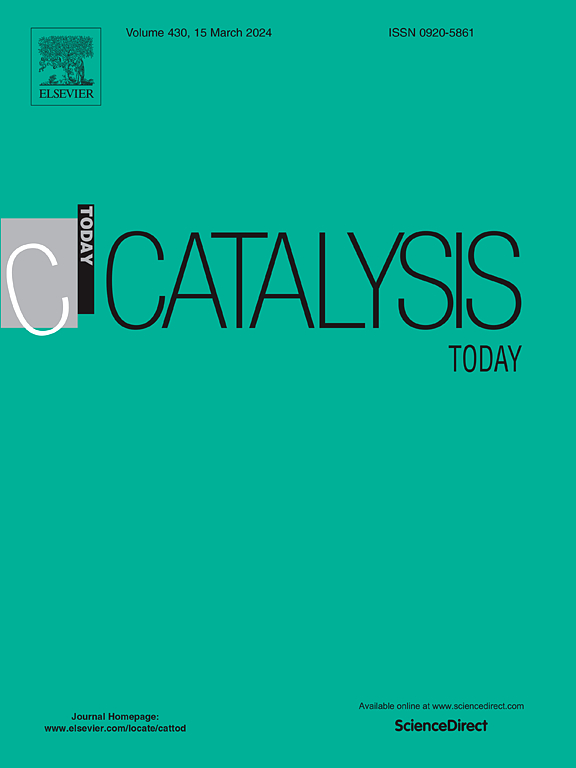Influence of CO2 presence on propane conversion routes over Cr- and Ga-doped PtCe/Al2O3 catalysts
IF 5.2
2区 化学
Q1 CHEMISTRY, APPLIED
引用次数: 0
Abstract
A set of catalysts containing Cr- or Ga-doped Pt-CeO2 supported on alumina (PCA, Cr-PCA and Ga-PCA) were synthesized by incipient wetness impregnation and tested in propane conversion processes. The catalysts were studied in the propane conversion process with or without CO2 in the feed. In all cases, an enhancement in stability was found when CO2 was present in the reaction medium despite the lower catalytic activity. As well, all catalysts presented a higher propylene selectivity in the absence of CO2, indicating that the direct dehydrogenation of propane is the main reaction route. Moreover, CO2-assisted propane cracking to ethylene is favoured over propane reforming or direct cracking, given the minimal selectivity to other products like methane. With regards to the catalyst composition, Cr-PCA catalyst was the most active catalyst both in the absence and presence of CO2, due to the presence of weak acidity and coexistence of Cr3 + and Cr6+ redox species, as evidenced by XPS analysis. Ga-PCA catalyst was more selective to propylene, indicating that higher acidity of weak-to-medium nature along with formation of low coordinated Ga3+ species is beneficial for the CO2-ODH process. Raman, DTG and XPS analyses after reaction with CO2 showed that the deactivation of the catalysts was mainly due to carbon deposits of amorphous and graphitic nature on the surface of the catalysts.
CO2存在对Cr和ga掺杂PtCe/Al2O3催化剂丙烷转化路线的影响
采用初湿浸渍法合成了一套氧化铝负载的含Cr或ga掺杂Pt-CeO2催化剂(PCA、Cr-PCA和Ga-PCA),并在丙烷转化过程中进行了测试。研究了在进料中有或无CO2的丙烷转化过程中催化剂的性能。在所有情况下,尽管催化活性较低,但当反应介质中存在CO2时,稳定性得到增强。在无CO2条件下,所有催化剂均表现出较高的丙烯选择性,说明丙烷的直接脱氢是主要的反应途径。此外,二氧化碳辅助丙烷裂解制乙烯比丙烷重整或直接裂解更受青睐,因为它对甲烷等其他产物的选择性很小。在催化剂组成方面,XPS分析表明,由于存在弱酸性和Cr3 +和Cr6+氧化还原物质共存,在无CO2和有CO2的情况下,Cr-PCA催化剂都是最活跃的催化剂。Ga-PCA催化剂对丙烯的选择性更强,表明较高的弱-中酸性和低配位Ga3+物质的形成有利于CO2-ODH过程。与CO2反应后的Raman、DTG和XPS分析表明,催化剂失活的主要原因是催化剂表面有非晶和石墨性质的碳沉积。
本文章由计算机程序翻译,如有差异,请以英文原文为准。
求助全文
约1分钟内获得全文
求助全文
来源期刊

Catalysis Today
化学-工程:化工
CiteScore
11.50
自引率
3.80%
发文量
573
审稿时长
2.9 months
期刊介绍:
Catalysis Today focuses on the rapid publication of original invited papers devoted to currently important topics in catalysis and related subjects. The journal only publishes special issues (Proposing a Catalysis Today Special Issue), each of which is supervised by Guest Editors who recruit individual papers and oversee the peer review process. Catalysis Today offers researchers in the field of catalysis in-depth overviews of topical issues.
Both fundamental and applied aspects of catalysis are covered. Subjects such as catalysis of immobilized organometallic and biocatalytic systems are welcome. Subjects related to catalysis such as experimental techniques, adsorption, process technology, synthesis, in situ characterization, computational, theoretical modeling, imaging and others are included if there is a clear relationship to catalysis.
 求助内容:
求助内容: 应助结果提醒方式:
应助结果提醒方式:


